Central Indiana: Realtors Region 4 Profile
Figure 1: Central Indiana: Realtors Region 4
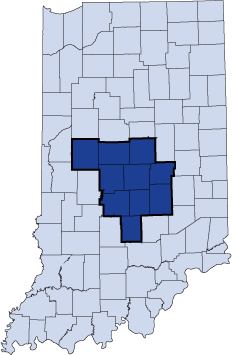
Source: IBRC, using the Indiana Association of Realtors definitions
This is the fourth article in our coverage of Indiana's Realtors regions. Housing is an important dimension of economic and community development in our state, so we are forging a partnership with the Indiana Association of Realtors to encourage understanding of the housing situation in Indiana. For an overview of this article series and a map of all six regions, see the first article at www.incontext.indiana.edu/2010/may-june/article5.asp.
Geographic Context
Realtors Region 4 consists of 10 counties smack dab in the center of the state in what is either called Central Indiana or the Indianapolis area.
With an estimated population of 1.7 million, it is the largest of all six regions. Counties in this region include Boone, Brown, Hamilton, Hancock, Hendricks, Johnson, Marion, Montgomery, Morgan and Shelby (see Figure 1). This region covers a land area of nearly 3,890 square miles and has a population density of nearly 450 people per square mile (that’s quite dense considering the rather roomy state average of 179 people per square mile).
Population
Indianapolis is the largest city in Realtors Region 4 as well as in the state with a 2009 population estimate of 807,584. Fishers (71,052) and Carmel (69,547) come in as a distant second and third largest in the region (see Table 1).
Table 1: Largest Cities in Region 4, 2009
| Name | Population in 2009 | % of Region |
|---|---|---|
| Indianapolis | 807,584 | 46.3% |
| Fishers | 71,052 | 4.1% |
| Carmel | 69,547 | 4.0% |
| Greenwood | 48,320 | 2.8% |
| Lawrence | 44,107 | 2.5% |
| Noblesville | 42,935 | 2.5% |
| Plainfield | 28,527 | 1.6% |
| Franklin | 23,595 | 1.4% |
| Westfield | 22,402 | 1.3% |
| Brownsburg | 20,644 | 1.2% |
Source: IBRC, using U.S. Census Bureau data
The population in Realtors Region 4 increased between Census 2000 and the latest estimate in 2009 by more than 200,000 people, for a solid 14.3 percent change so far this decade (see Figure 2). The population in Realtors Region 4 is projected to continue its growth through 2015, by which time its population would be close to 1.9 million according to the official county population projections from the Indiana Business Research Center.
Figure 2: Region 4 Population Levels, 1981 to 2009
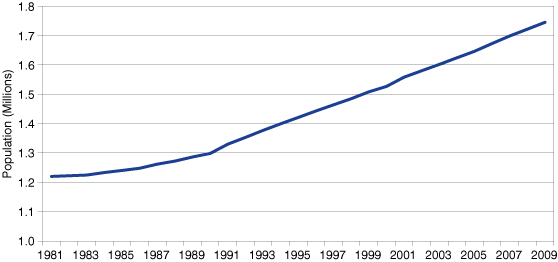
Source: IBRC, using U.S. Census Bureau data
This region has an age mix that differs from the state mix (see Figure 3). Realtors Region 4 has a higher proportion of young adults, preschoolers and school age children than the state overall.
Figure 3: Current Age Structure, 2009
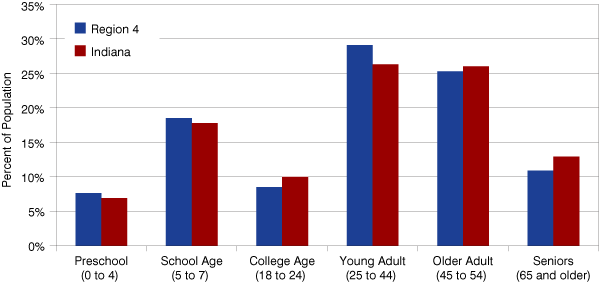
Source: IBRC, using U.S. Census Bureau data
Among the six Realtors regions, Region 4 ranks first in net migration from other nations, with 2,851 more people moving into the region from overseas or across borders between 2008 and 2009 than moving out. The region had a domestic net increase of 7,314 people—that is, in-migration to this region outpaced out-migration by a considerable number.
About 82 percent of the population is white, making this the least homogenous region among the six. Fifteen percent of the population is black (compared to the state’s 9.1 percent), and a little over 5 percent of the region’s population is Hispanic (which is somewhat smaller than the statewide 5.5 percent estimated for 2009).
Housing and Life Styles
The region ranks first among the six regions with 760,596 housing units (2009 estimate). The majority of units (62.3 percent) were owner-occupied, according to Census 2000, although the region has a significant share of the state’s rental housing. More than half of households in the region were married couples (23.8 percent with children, 27.1 percent without), 10 percent were single-parent households, and 27 percent lived alone.
Home sales in the region, not surprisingly, have slowed along with the rest of the state and the nation. Regardless, the region accounted for 36 percent of all homes sold in the state in 2009, compared to 35 percent in 2005. The median sale price has shifted downward, from $130,000 in 2005 to $118,000 in 2009, so Region 4 is part of that nationwide buyer’s market.
In 2009, nearly 23,300 homes were sold in the central region, with a median age of 17 years (that is, median year built was 1992). That median age was definitely younger when compared to the state, with a median build-year of 1976 (see Figure 4).
Figure 4: Percent of Homes Sold in 2009 by Year Built
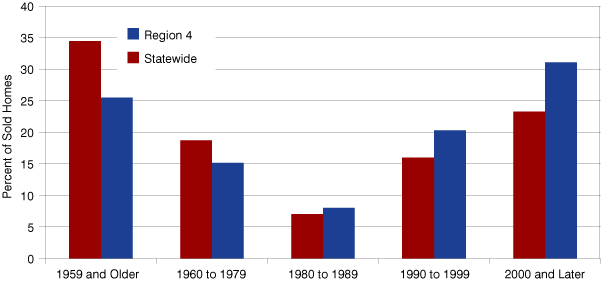
Source: IBRC, using Indiana Association of Realtors data
Looking at individual counties in the region, there is a significant spread based on the median age of homes sold in 2009 (see Figure 5).
Figure 5: Median Age of Homes Sold in 2009 by County in Realtors Region 4

Source: IBRC, using Indiana Association of Realtors data
The vast majority of homes sold were priced under $200,000 and about 50 homes were sold for $1 million or more in 2009. Using a statewide comparison, the region’s home sales occurred at a higher frequency in the ranges above $100,000 (see Figure 6).
Figure 6: Cost of Homes Sold Compared to the State, 2009
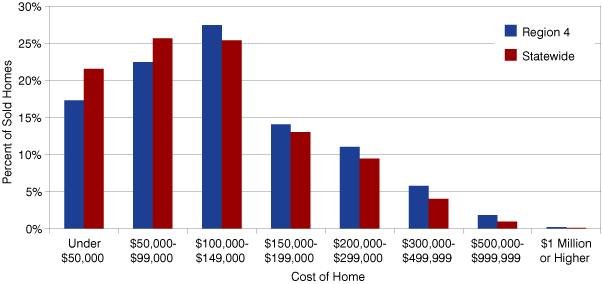
Source: IBRC, using Indiana Association of Realtors data
Labor Force
As seen in Figure 7, nearly 900,000 residents of the region are part of the labor force, with 820,000 people employed and the remaining 75,000 actively seeking work (i.e., unemployed), based on 2009 annual average). The September 2010 unemployment rate for the region was 8.7 percent, lower than the state rate of 9.5 percent for that same month (figures are not seasonally adjusted). For a closer inspection of labor force numbers, be sure to visit Hoosiers by the Numbers at www.hoosierdata.in.gov, the workforce development website of the Indiana Department of Workforce Development. These numbers are released monthly as preliminary estimates and previous months’ figures are revised.
Figure 7: Realtors Region 4 Resident Labor Force and Employment, 1990 to 2009
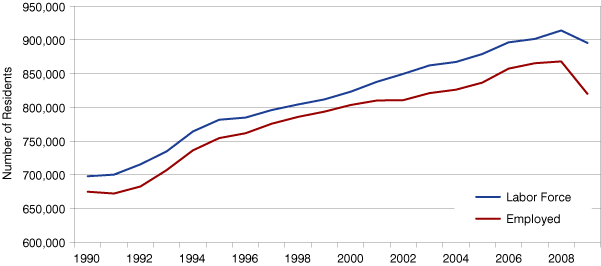
Note: Data are not seasonally adjusted.
Source: IBRC, using Indiana Department of Workforce Development data
Work
The vast majority of residents work in private industry. The largest sectors in the region include health care and social services, retail trade, and manufacturing (see Table 2).
Table 2: Realtors Region 4 Jobs by Industry, 2009
| Industry | Jobs | Jobs LQ |
|---|---|---|
| Total | 830,118 | 1.00 |
| Health Care and Social Services | 101,337 | 0.64 |
| Retail Trade | 88,938 | 0.75 |
| Manufacturing | 87,302 | 1.14 |
| Accommodation and Food Services | 71,208 | 0.85 |
| Administrative and Support and Waste Management and Remediation Services | 58,871 | 1.09 |
| Transportation and Warehousing | 49,722 | 1.45 |
| Public Administration | 42,619 | 0.88 |
| Professional, Scientific, and Technical Services | 41,462 | 0.51 |
| Finance and Insurance | 40,796 | 0.68 |
| Construction | 38,533 | 0.99 |
| Wholesale Trade | 38,359 | 0.84 |
| Other Services (Except Public Administration) | 26,510 | 0.80 |
| Information | 15,926 | 0.71 |
| Real Estate and Rental and Leasing | 14,259 | 0.91 |
| Educational Services | 13,638 | 0.16 |
| Arts, Entertainment, and Recreation | 12,111 | 0.60 |
| Management of Companies and Enterprises | 10,875 | 0.91 |
| Utilities | 3,976 | 0.75 |
| Agriculture, Forestry, Fishing and Hunting | 1,160 | 0.16 |
| Mining | 641 | 0.16 |
| Unallocated | 33 | 0.03 |
Source: IBRC, using U.S. Bureau of Labor Statistics data
Jobs within Industry Cluster
Clusters can be a valuable way to organize our thinking about industry mix in an area. The Purdue Center for Regional Development has identified 17 industry clusters that give insight into the core industries and their supplier industries. The resulting data can help the region consider which are important or emerging clusters (see Table 3).
Table 3: Realtors Region 4 Industry Clusters, 2008
| Description | Cluster Employment | Industry Cluster Employment LQ |
|---|---|---|
| Total All Industries | 870,084 | 1.00 |
| Business and Financial Services | 78,309 | 1.03 |
| Transportation and Logistics | 43,227 | 1.69 |
| Biomedical/Biotechnical (Life Sciences) | 42,257 | 1.41 |
| Manufacturing Supercluster | 42,246 | 1.01 |
| Defense and Security | 36,039 | 0.84 |
| Energy (Fossil and Renewable) | 35,315 | 0.68 |
| Information Technology and Telecommunications | 28,657 | 0.70 |
| Chemicals and Chemical Based Products | 23,342 | 1.60 |
| Arts, Entertainment, Recreation and Vistor Industries | 21,095 | 0.61 |
| Advanced Materials | 16,596 | 0.49 |
| Printing and Publishing | 16,513 | 0.99 |
| Education and Knowledge Creation | 15,709 | 0.19 |
| Transportation Equipment Manufacturing* | 15,431 | 1.46 |
| Fabricated Metal Product Manufacturing* | 12,560 | 1.27 |
| Forest and Wood Products | 11,089 | 0.69 |
| Agribusiness, Food Processing and Technology | 9,055 | 0.44 |
| Machinery Manufacturing* | 7,918 | 1.04 |
| Computer and Electronic Product Manufacturing* | 4,256 | 0.53 |
| Apparel and Textiles | 4,042 | 0.55 |
| Glass and Ceramics | 2,936 | 0.85 |
| Primary Metal Manufacturing* | 1,296 | 0.45 |
| Electrical Equipment, Appliance and Component Manufacturing* | 785 | 0.29 |
| Mining | 651 | 0.49 |
*These are subclusters within the manufacturing supercluster.
Source: IBRC, using U.S. Bureau of Labor Statistics and Purdue Center for Regional Development data
In using the table, it’s worthwhile to consider the actual employment numbers shown. It’s almost always good to consider “how many” jobs comprise a particular cluster. Another valuable measure is the location quotient (LQ) provided in the column next to the employment numbers. Anything over 1.0 means the region has what is considered export capacity—exporting to neighbors in another region, another state, across the nation or around the globe. The idea of producing “more than we need” indicates that those clusters are serving needs outside the region as well as within its borders. In short, having an LQ higher than 1.0 is good; if it is a lot higher, then the cluster can be considered substantial, and is at least worth a closer look as part of an economic development strategy.
If clusters have piqued your interest, be sure to turn your browser to www.statsamerica.org/innovation to see these data in action for areas throughout Indiana and in comparison to the rest of the country.
Time to Explore
We hope to have given you a fast trek through the numbers. We could go on, but then that might spoil your fun in going to STATS Indiana’s IN Depth Profiles and learning more about this region or the whole host of regions we have available.
Carol O. Rogers
Deputy Director, Indiana Business Research Center, Indiana University Kelley School of Business
